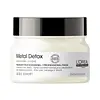What's inside
What's inside
 Key Ingredients
Key Ingredients

 Benefits
Benefits

 Concerns
Concerns

 Ingredients Side-by-side
Ingredients Side-by-side

Water
Skin ConditioningCetearyl Alcohol
EmollientParaffinum Liquidum
EmollientDipalmitoylethyl Hydroxyethylmonium Methosulfate
Cetyl Esters
EmollientCI 77891
Cosmetic ColorantCI 77491
Cosmetic ColorantCI 15985
Cosmetic ColorantCI 19140
Cosmetic ColorantChamomilla Recutita Extract
Skin ConditioningMica
Cosmetic ColorantCocos Nucifera Oil
MaskingTrideceth-6
EmulsifyingChlorhexidine Digluconate
AntimicrobialHelianthus Annuus Seed Oil
EmollientLinum Usitatissimum Flower Extract
Skin ConditioningAmodimethicone
Caprylyl Glycol
EmollientCaprylic/Capric Triglyceride
MaskingCaramel
Cosmetic ColorantGardenia Taitensis Flower Extract
Skin ConditioningRosa Canina Flower Extract
AstringentBisabolol
MaskingCetrimonium Chloride
AntimicrobialBHT
AntioxidantCitric Acid
BufferingGlycine Soja Oil
EmollientParfum
MaskingWater, Cetearyl Alcohol, Paraffinum Liquidum, Dipalmitoylethyl Hydroxyethylmonium Methosulfate, Cetyl Esters, CI 77891, CI 77491, CI 15985, CI 19140, Chamomilla Recutita Extract, Mica, Cocos Nucifera Oil, Trideceth-6, Chlorhexidine Digluconate, Helianthus Annuus Seed Oil, Linum Usitatissimum Flower Extract, Amodimethicone, Caprylyl Glycol, Caprylic/Capric Triglyceride, Caramel, Gardenia Taitensis Flower Extract, Rosa Canina Flower Extract, Bisabolol, Cetrimonium Chloride, BHT, Citric Acid, Glycine Soja Oil, Parfum
Sodium Cocoyl Isethionate
CleansingDisodium Laureth Sulfosuccinate
CleansingGlycol Distearate
EmollientSodium Lauryl Sulfoacetate
CleansingSodium Lauroyl Sarcosinate
CleansingGlycerin
HumectantParfum
MaskingPPG-5-Ceteth-20
EmulsifyingDecyl Glucoside
CleansingCocamidopropyl Betaine
CleansingCoco-Betaine
CleansingDivinyldimethicone/Dimethicone Copolymer
Amodimethicone
Citric Acid
BufferingSodium Hydroxide
BufferingPolyquaternium-7
Polyquaternium-10
Carbomer
Emulsion StabilisingSodium Benzoate
MaskingSodium Chloride
MaskingLimonene
PerfumingPEG-55 Propylene Glycol Oleate
Propylene Glycol
HumectantSalicylic Acid
MaskingBenzoic Acid
MaskingPolysorbate 21
EmulsifyingHexyl Cinnamal
PerfumingLinalool
PerfumingTrideceth-6
EmulsifyingC12-13 Pareth-23
CleansingC12-13 Pareth-3
EmulsifyingCitral
PerfumingGeraniol
PerfumingGlycine
BufferingTocopherol
AntioxidantCetrimonium Chloride
AntimicrobialPhenoxyethanol
PreservativeSodium Cocoyl Isethionate, Disodium Laureth Sulfosuccinate, Glycol Distearate, Sodium Lauryl Sulfoacetate, Sodium Lauroyl Sarcosinate, Glycerin, Parfum, PPG-5-Ceteth-20, Decyl Glucoside, Cocamidopropyl Betaine, Coco-Betaine, Divinyldimethicone/Dimethicone Copolymer, Amodimethicone, Citric Acid, Sodium Hydroxide, Polyquaternium-7, Polyquaternium-10, Carbomer, Sodium Benzoate, Sodium Chloride, Limonene, PEG-55 Propylene Glycol Oleate, Propylene Glycol, Salicylic Acid, Benzoic Acid, Polysorbate 21, Hexyl Cinnamal, Linalool, Trideceth-6, C12-13 Pareth-23, C12-13 Pareth-3, Citral, Geraniol, Glycine, Tocopherol, Cetrimonium Chloride, Phenoxyethanol
 Reviews
Reviews

Ingredients Explained
These ingredients are found in both products.
Ingredients higher up in an ingredient list are typically present in a larger amount.
This water-soluble silicone is used for its hydrating and softening properties. It is used to add a silky feel to skincare products and has great benefits for haircare.
In haircare, this ingredient:
- Adds shine
- Protects color
- Offers thermal protection
- Boosts hair strength
- Does not build up as easily
This ingredient is a preservative, antimicrobial, and emulsifier. It is often used in cosmetics for its ability to cleanse, condition, and reduce static.
Cetrimonium chloride is a quaternary ammonium salt, meaning it has a water-soluble structure.
Citric Acid is an alpha hydroxy acid (AHA) naturally found in citrus fruits like oranges, lemons, and limes.
Like other AHAs, citric acid can exfoliate skin by breaking down the bonds that hold dead skin cells together. This helps reveal smoother and brighter skin underneath.
However, this exfoliating effect only happens at high concentrations (20%) which can be hard to find in cosmetic products.
Due to this, citric acid is usually included in small amounts as a pH adjuster. This helps keep products slightly more acidic and compatible with skin's natural pH.
In skincare formulas, citric acid can:
While it can provide some skin benefits, research shows lactic acid and glycolic acid are generally more effective and less irritating exfoliants.
Most citric acid used in skincare today is made by fermenting sugars (usually from molasses). This synthetic version is identical to the natural citrus form but easier to stabilize and use in formulations.
Read more about some other popular AHA's here:
Learn more about Citric AcidParfum is a catch-all term for an ingredient or more that is used to give a scent to products.
Also called "fragrance", this ingredient can be a blend of hundreds of chemicals or plant oils. This means every product with "fragrance" or "parfum" in the ingredients list is a different mixture.
For instance, Habanolide is a proprietary trade name for a specific aroma chemical. When used as a fragrance ingredient in cosmetics, most aroma chemicals fall under the broad labeling category of “FRAGRANCE” or “PARFUM” according to EU and US regulations.
The term 'parfum' or 'fragrance' is not regulated in many countries. In many cases, it is up to the brand to define this term.
For instance, many brands choose to label themselves as "fragrance-free" because they are not using synthetic fragrances. However, their products may still contain ingredients such as essential oils that are considered a fragrance by INCI standards.
One example is Calendula flower extract. Calendula is an essential oil that still imparts a scent or 'fragrance'.
Depending on the blend, the ingredients in the mixture can cause allergies and sensitivities on the skin. Some ingredients that are known EU allergens include linalool and citronellol.
Parfum can also be used to mask or cover an unpleasant scent.
The bottom line is: not all fragrances/parfum/ingredients are created equally. If you are worried about fragrances, we recommend taking a closer look at an ingredient. And of course, we always recommend speaking with a professional.
Learn more about ParfumWe don't have a description for Trideceth-6 yet.